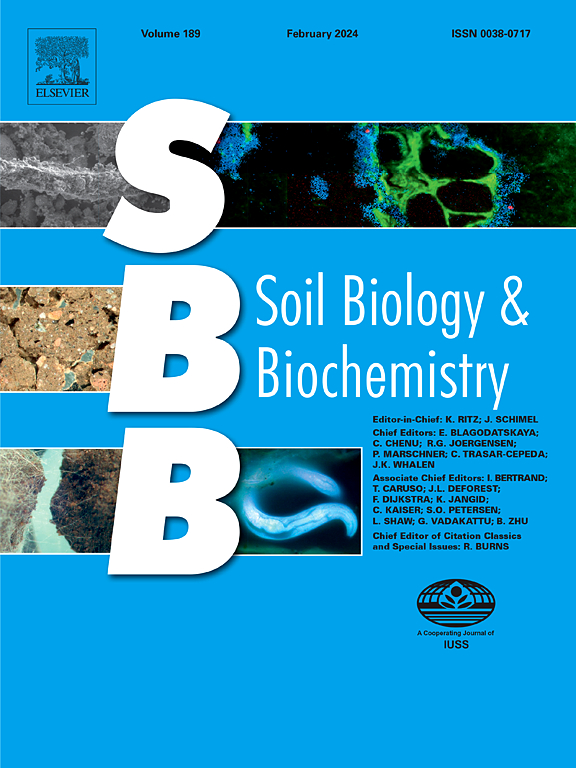Arbuscular mycorrhizal fungi hyphal density rather than diversity stimulates microbial necromass accumulation after long-term Robinia pseudoacacia plantations
IF 9.8
1区 农林科学
Q1 SOIL SCIENCE
引用次数: 0
Abstract
Robinia pseudoacacia plantations are an effective strategy for preventing soil erosion, enhancing soil fertility, and stimulating carbon (C) sequestration in barren systems, supported by symbioses with arbuscular mycorrhizal (AM) fungi and rhizobia. However, the effects of AM fungal diversity and hyphal density on microbial necromass and SOC accumulation after long-term Robinia pseudoacacia plantations remain unclear. We hypothesize that increased AM fungal diversity and hyphal density after afforestation stimulate SOC formation by facilitating fungal and bacterial necromass C (FNC and BNC), glomalin (GRSP), and extracellular polymeric substances (EPS), with the contributions increasing as forest age. To test this hypothesis, microbial necromass, SOC, AM fungal diversity, and hyphal density were measured in surface soil (0–20 cm) and subsurface soil (20–40 cm) of Robinia pseudoacacia plantations aged 10, 15, 20, 35, and >50 years. Results showed that SOC accumulation was largely confined to surface soil, predominantly as mineral-associated organic C (MAOC). The content of FNC, GRSP, and EPS-polysaccharide in surface soil also increased with stand age, which is closely associated with MAOC. This emphasizes that long-term Robinia pseudoacacia plantations primarily stimulate C accumulation in surface soil, likely due to GRSP and EPS-polysaccharide aiding in the aggregation and protection of microbial necromass C. Although the AM fungal diversity in surface soil decreased with stand age, the hyphal density increased alongside root biomass. The increase in hyphal density could facilitate FNC and EPS formation, thereby contributing to the MAOC and SOC accumulation. In contrast, the content of SOC and microbial necromass C in subsurface soil showed an absence of differences or was reduced. Overall, this study reveals that microbial necromass and SOC accumulation after Robinia pseudoacacia plantations occur in surface soil, with AM fungal hyphal density and associated exudates, rather than AM fungal diversity, serving as key predictors.


刺槐种植是防止土壤侵蚀、提高土壤肥力和促进贫瘠系统固碳的一种有效策略,它得到了丛枝菌根真菌(AM)和根瘤菌的共生支持。然而,长期种植刺槐后,AM 真菌的多样性和菌丝密度对微生物坏死物质和 SOC 积累的影响仍不清楚。我们假设,造林后 AM 真菌多样性和菌丝密度的增加会促进真菌和细菌坏死物质 C(FNC 和 BNC)、胶霉素(GRSP)和胞外聚合物物质(EPS),从而刺激 SOC 的形成,其贡献会随着林龄的增加而增加。为了验证这一假设,对树龄分别为 10 年、15 年、20 年、35 年和 50 年的刺槐人工林表层土壤(0-20 厘米)和地下土壤(20-40 厘米)中的微生物坏死物质、SOC、AM 真菌多样性和菌丝密度进行了测量。结果表明,SOC 的积累主要局限于表层土壤,主要表现为矿物相关有机碳(MAOC)。表层土壤中 FNC、GRSP 和 EPS 多糖的含量也随着树龄的增加而增加,这与 MAOC 密切相关。这说明长期的刺槐种植主要刺激了表层土壤中的碳积累,这可能是由于 GRSP 和 EPS 多糖有助于聚集和保护微生物的坏死碳。菌丝密度的增加可促进 FNC 和 EPS 的形成,从而有助于 MAOC 和 SOC 的积累。相比之下,地表下土壤中的 SOC 和微生物坏死物质 C 的含量没有差异或有所减少。总之,这项研究揭示了刺槐种植后微生物坏死物质和 SOC 的积累发生在表层土壤中,AM 真菌的头状菌密度和相关渗出物,而不是 AM 真菌的多样性是关键的预测因素。
本文章由计算机程序翻译,如有差异,请以英文原文为准。
求助全文
约1分钟内获得全文
求助全文
来源期刊

Soil Biology & Biochemistry
农林科学-土壤科学
CiteScore
16.90
自引率
9.30%
发文量
312
审稿时长
49 days
期刊介绍:
Soil Biology & Biochemistry publishes original research articles of international significance focusing on biological processes in soil and their applications to soil and environmental quality. Major topics include the ecology and biochemical processes of soil organisms, their effects on the environment, and interactions with plants. The journal also welcomes state-of-the-art reviews and discussions on contemporary research in soil biology and biochemistry.
 求助内容:
求助内容: 应助结果提醒方式:
应助结果提醒方式:


